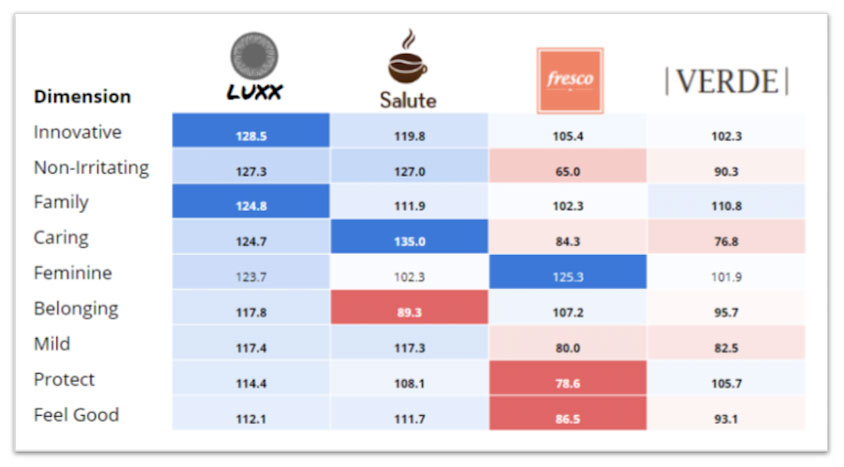Jonathan Mall, CEO and founder of Neuro Flash, explains why big data and AI will dominate research and marketing in the near future.

At ESOMAR’s Fusion event last November, Jonathan Mall explained how AI leads to better marketing decisions. His company, Neuro Flash, performs neuro-semantic analysis with the help of big data, created with 30 plus billion words from any target market. This, he believes, enables the firm to reveal conscious and subconscious associations that determine the true position of a brand.
You’re a neuropsychologist turned data scientist and entrepreneur, how do these three functions benefit from each other?
The scientific method is the only reliable way of understanding a complex world, that’s what I’ve learned studying neuropsychology. Data science is a tool to finding relationships in large data sets. And being an entrepreneur means that I can go through the steps of this powerful method – question, hypothesis, prediction, testing, analysis – and focus on solutions that provide value in the market. The areas do clash though. As a scientist, one always says: ‘We find a reliable effect, but need more studies to understand it better’, highlighting the lack of complete knowledge. But as an entrepreneur I need to stick to the 80:20 rule: the 80 per cent is relevant enough for significant business impact.
What makes the combination of psychology and data science so enticing?
It enables us to predict what people think and helps us understand why, without the need to talk to them. People often can’t say what their intentions are, but with the right data we can predict what they think with surprisingly high accuracy. Implicit tests and neuromarketing have already proven how successful this approach is for more effective marketing. We build on that with an AI that simulates how consumers learn about the world. This allows marketers to connect with consumers more effectively, resulting in improved ROAS (return on advertising spend, ed.). We could produce thousands of Excel cells of data, but what our clients prefer is to see one graphic that speaks for itself; showing what their brand stands for and how relevant that is in comparison to the competition. The simpler we present the insights, the more creative our clients can become to develop marketing in the right direction.
Challenge
How is brand positioned in a selected market in comparison with its major competitors?
Results
Revealing what makes a brand unique in the marketplace.identifying specific brand values to improve the brand position towards the target.

What is the role of AI in understanding the associations that people have with particular brands or wording?
Our AI is based on extremely large text and image datasets that most consumers use to understand the world and the brands within it. We do this because neuroscience has shown that people’s judgments are based on the knowledge and associations they have learned. The AI therefore uses the data to learn human judgments and associations. In today’s competitive world it becomes very difficult for even the best CMO’s, to keep understanding what drives the impact of their own brand as well as competing brands. Using AI we can predict what consumers think about brands, based on the relevant brand information consumers have access to and on their engagement with brands.
In which stage of developing an advertising and marketing campaign do you generally work?
Strategic brand positioning is core to us and has an impact on all other challenges for a brand. The AI determines the current position and the most promising strategic directions. Then we develop fitting concepts and content execution with the AI as a content co-pilot. Our methodology is most powerful if a brand needs clarity on its current position, is about to be re-positioned or needs to be built up from scratch. Overall our AI can be used in many different aspects from strategic to executional and workshops.
It’s wider than traditional testing because the sheer size of data coupled with machine learning allows you to track unlimited numbers of brands and across a multitude of countries. It also goes deeper because it offers you so many different word choices and their weighting – not even a linguistic genius could cough those up. Since you can use the tool on the spot, you can now play around with different wording right there in a meeting and go deeper into unbiased discussions and solutions. On top of this it can derive conclusions from gigantic datasets where traditional testing cannot cope. In today’s world we need to accept that AI is superior in data processing and can act as a co-pilot for finding insights.
In today’s world we need to accept that AI is superior in data processing and can act as a co-pilot for finding insights.
What are some of the practical applications of this?
Focus groups and online studies are unfortunately often used to confirm the outcomes and insights the marketer already has. AI can disrupt this confirmation bias because it confronts us with objective data, reflecting what consumers think in unlimited dimensions. For example, we looked at the meaning of ‘touch’ in Europe, Asia and the US and found large differences. For Italians touch is connected with positive topics such as family and friendship. But Germans mostly think of negative things, such as an unpleasant feeling and foreign object. In order to communicate touch most effectively, we asked the AI to find touch associations that were positive and pleasant within each market, leading to very different and successful campaigns across the globe. The marketer got all those insights from one place: an AI that was able to connect the dots for consumers in each market, from one central interface.
Is AI a separate stream or just another tool to automate operations and cut costs within existing insights approaches?
The insights industry is investing very little in AI. That’s partly because many clients haven’t seen its true power yet. But I believe that start-ups like ours are helping to bridge the knowledge and outcome gap to stimulate higher investments.
We believe that AI should take over the boring tasks and allow marketers to open their minds and discover relevant insights from the relevant data. The speed at which data is being processed, and the ability to curate the data to only show the important connections, that’s where AI can be the most effective as a tool to making better, human decisions.
If for instance the training data is inaccurate, an error can become part of the algorithm, leading to biased outcomes. What steps does your company take to minimise bias?
Our data is 100 percent biased, that is the whole point, because people are biased. People believe that organic carrots are better than genetically enhanced carrots and they often underestimate the strengths of women in leadership positions. We therefore benchmark our algorithms by the implicit biases and explicit behaviour that we know exist in the population. As a company, we take steps to be as close to reality with our predictions. Biased, irrational humans are our benchmark because brands and products are evaluated and get bought by them.
Biased, irrational humans are our benchmark because brands and products are evaluated and get bought by them.
Where do you expect to see most innovation in AI and big data applications; big global firms or start-ups?
Start-ups are faster to experiment and find novel solutions. Big companies are richer in data and money but are generally slower in developing solutions. So we should expect the biggest, market-penetrating innovations coming from big businesses that buy the start-ups with the right solutions. Another important variable is access to data. That’s where Google, Facebook and Amazon, but also Alibaba and the Chinese Government, have a great position to teach AI’s new tricks.
What role will AI play in research and marketing over the next few years?
AI will take over everything. It will take longer than most evangelists believe, but in the long run it will change more than we can currently imagine. Therefore we work on modelling all aspects of marketing-relevant consumer behaviour. In the end it will be possible to predict attention, consideration and purchasing behaviour as a result of consuming any marketing texts, images, videos and sounds for any target group.
At the same time you say that the insights industry is investing very little in AI. What will it take to convince sceptics?
Change always takes time, even with the current AI popularity. AI agencies will continue to take away market share from the big guys and eventually AI platforms will make many analyst positions obsolete. A real turning point would come when an AI develops and markets a new product all by itself. But for that to be possible, a lot more needs to happen.
Top tips
What Neuro Flash learned from applying its approach to brand and media communications:
- Repeating the right associations persuades consumers.
- What works is a simple message, one that is easy to process and understand, and associated with relevant cues for the product category.
- Use frequent words rather than infrequent ones.
- Use clear statements such as ‘The softest skin in 10 seconds’.
- Above all: keep the message in line with the brand equity and relevant product features (e.g. playing the right music behind a video spot, using fitting props and images, and ensuring that every word is clear and appropriately associated by your target group.
Case studies
Volkswagen: Neuro Flash helps to position the Volkswagen brand and produce engaging and persuasive content in a number of markets. It optimised the social media content by identifying the best topics and words for improved reach, resulting in improved ROAS.
FMCG brand: A big FMCG client tried for over 20 years to translate the meaning of a key brand image item from English to Japanese. Neuro Flash checked the appropriate associations in Japanese and found a term that was frequent, associated with the right things and not claimed by the competition. After the adoption market share grew by 3 pp (percentage points).
Leading ice cream brand: Using AI to compare the ice-cream brand’s own strategy with brands that were wildly different, but were already strong on associations that the brand wanted to explore. This resulted in a clear picture on where the brand should go, as well as providing the influencers that matched its goals.

Dr. Jonathan T. Mall is a cognitive neuropsychologist and entrepreneur. Frustrated by the small data in academia he turned to the internet to find the big datasets that explain how people think. After leading an IBM backed big data venture in the Netherlands, he founded Neuro Flash in the Microsoft Accelerator, a global initiative supporting start-ups. His company services clients in FMCG, automotive and telecommunication. Mall aims to disrupt the marketing industry by revolutionising the way we generate consumer insights and redefine effective marketing.


